
 |
Eager Space | Videos | All Video Text | Support | Community | About |
|---|

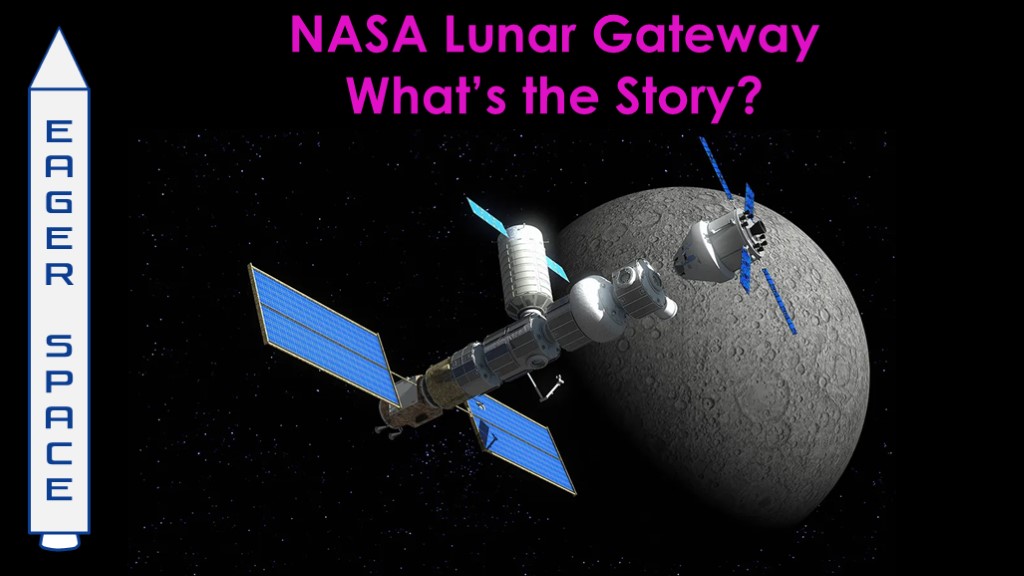
Mia and the martians:
https://www.indiegogo.com/projects/mia-and-the-martians-publishing-campaign#/
Off Nominal Podcase episode
https://offnom.com/episodes/166
Gateway white paper, 2022:
https://www.nasa.gov/wp-content/uploads/2023/10/acr22-wp-gateway-the-cislunar-springboard.pdf?emrc=5a0843
GAO-24-106878 NASA should document and communicate plans to address gateway's mass risk
https://www.gao.gov/assets/gao-24-106878.pdf
NASA crewed mars mission architecture (2023)
https://x.com/KenKirtland17/status/1745931455199338512?lang=en
Artemis lunar architecture video
https://www.youtube.com/watch?v=O2IBV_XSu60
Asteroid retrieval crewed mission:
https://ntrs.nasa.gov/api/citations/20140008285/downloads/20140008285.pdf
Overview of mission design for NASA asteroid redirect robotic mission concept.
https://www.trylam.com/files/IEPC_2013_Overview_of_Mission_Design_for_NASA_ARRM.pdf
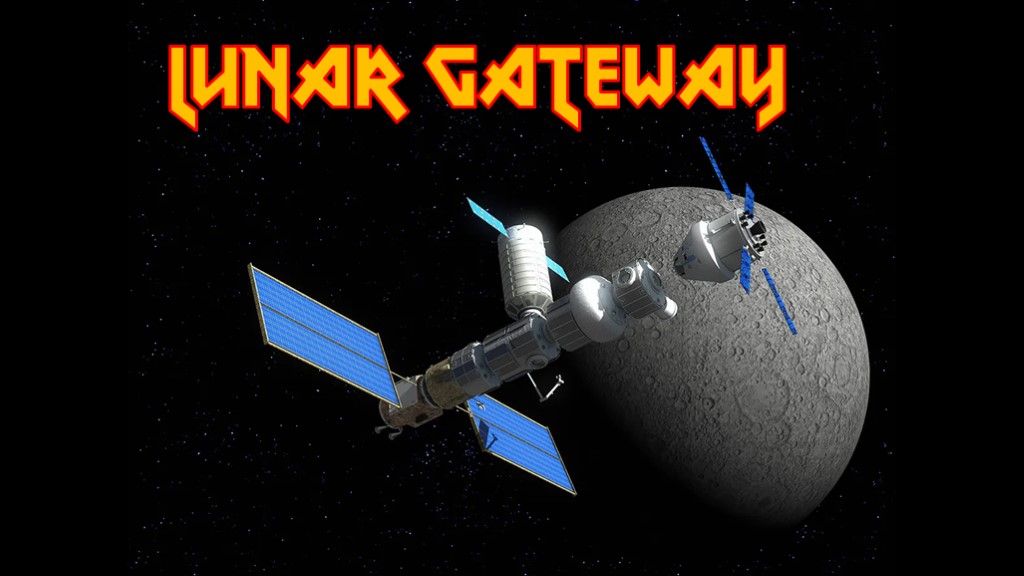
Lunar Gateway - or just gateway - is the name of the space station that NASA is planning on putting in a near rectilinear halo orbit around the moon, the same orbit that the orion capsule will be using for Artemis lunar landing missions.
You can think of it as a space station like ISS but smaller and not continuously occupied.
How did this program come about? Like many NASA programs, there's a bit of a story.
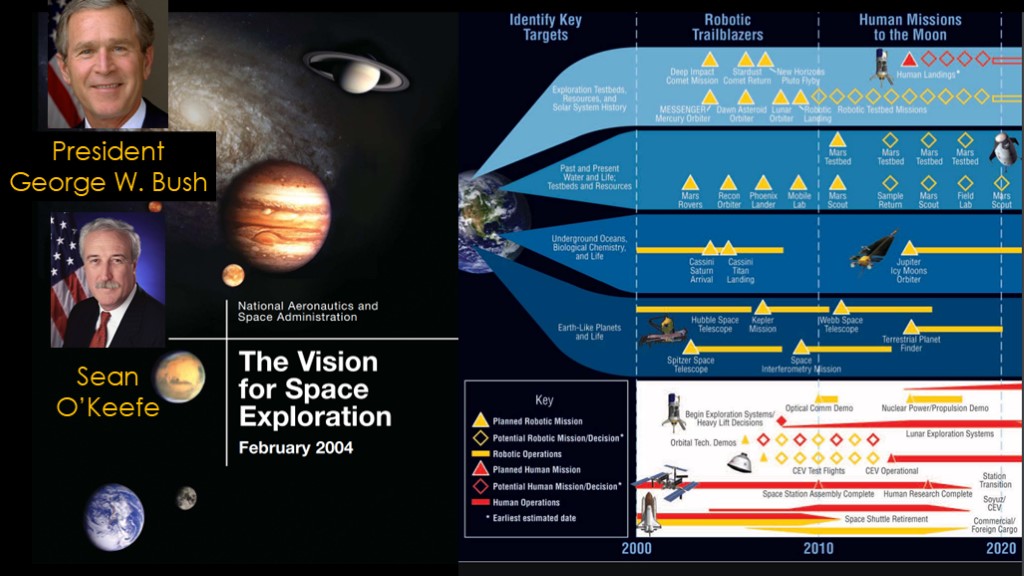
After the columbia accident in 2003, president George W. Bush and NASA administrator Sean O'Keefe worked to put NASA on a new path, and that resulted in the Vision for Space Exploration in February 2004.
I've sometimes described it as the "full meal deal" for NASA; they put pretty much everything they'd wanted to do into the vision.
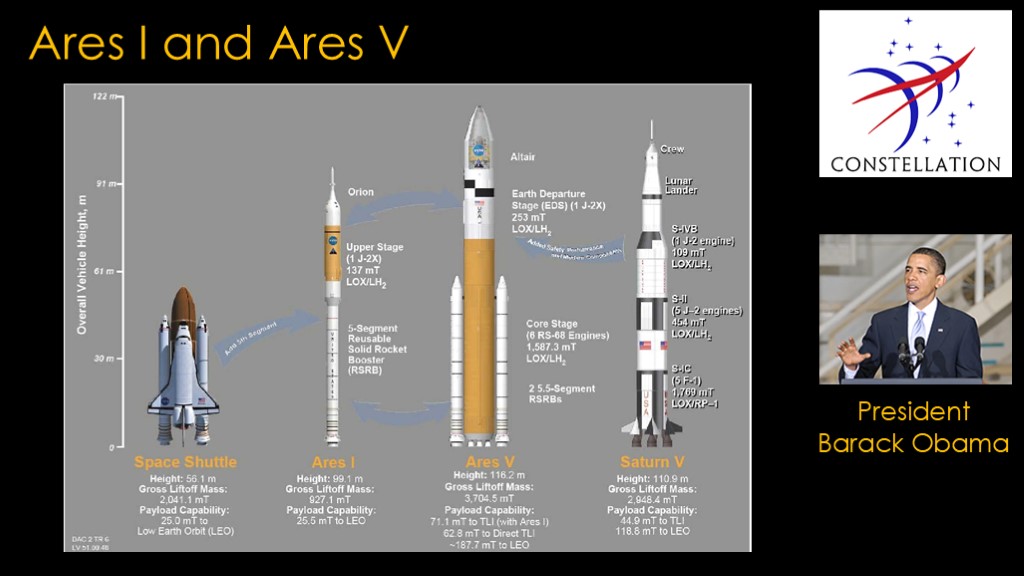
With the shuttle scheduled to be retired, that meant NASA needed a replacement rocket, and the constellation program came up with two, the Ares V, which was an absolute beast and the Ares I which would carry a new astronaut capsule named Orion.
Both were heavily based on shuttle technology for a number of reasons, some of them sound technical reasons, some of them purely political. The first goal of the program was to return astronauts to the surface of the moon.
The constellation program made slow progress; during the first 4 years it only produced a bad test version of the Ares I.
When President Obama came into office in 2009, he commissioned a review of NASA and the resulting report said NASA had too much on their plate; they could not afford finishing the space station, operating the space station, and building the hardware that constellation would require.
Obama ended up "cancelling" constellation, and there are air quotes around the word "cancelled" because although NASA is under the control of the executive branch, their money all comes from congress.
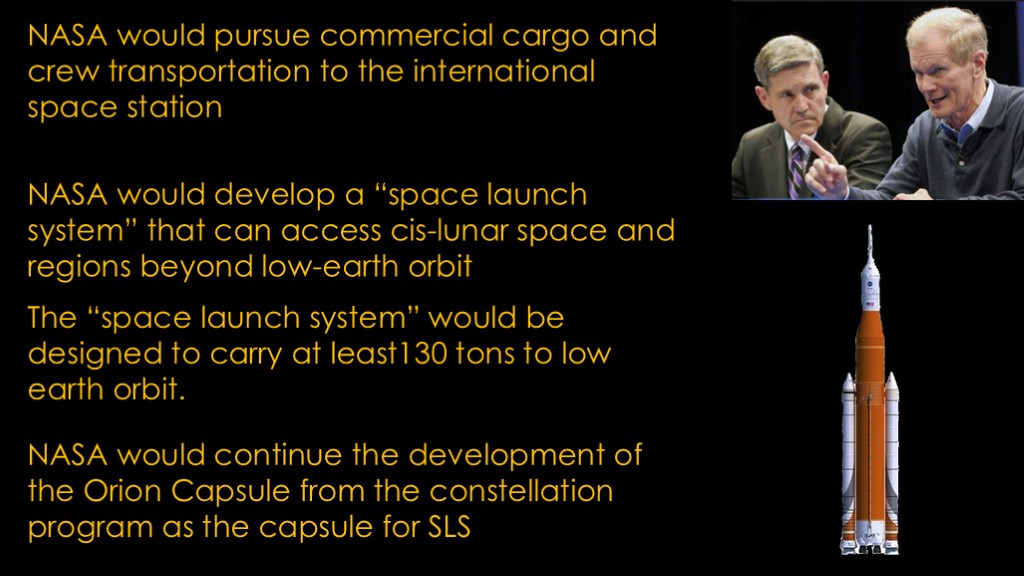
Congress did not take kindly to what they viewed as the interference of the president. After some negotiation, we ended up with the following:
The president got a commitment for NASA to pursue commercial cargo and crew programs to the ISS.
Congress got a program to develop a "space launch system" that could get out of low earth orbit to access cis-lunar space, and that rocket would be designed to carry at least 130 tons to low earth orbit.
The fine print required SLS to be made out of shuttle parts and utilize constellation contracts wherever possible. Congress was not going to run the risk that NASA would choose a new architecture this time.
Congress also told NASA to keep working on the Orion capsule that was part of constellation so it could be launched by SLS.
We can tell the priorities of Congress by noting that the act that authorized SLS gave no specifics of the missions that it would fly, just that they would be beyond low earth orbit.
That left NASA with a problem. What would they do with this new launch system and new capsule?
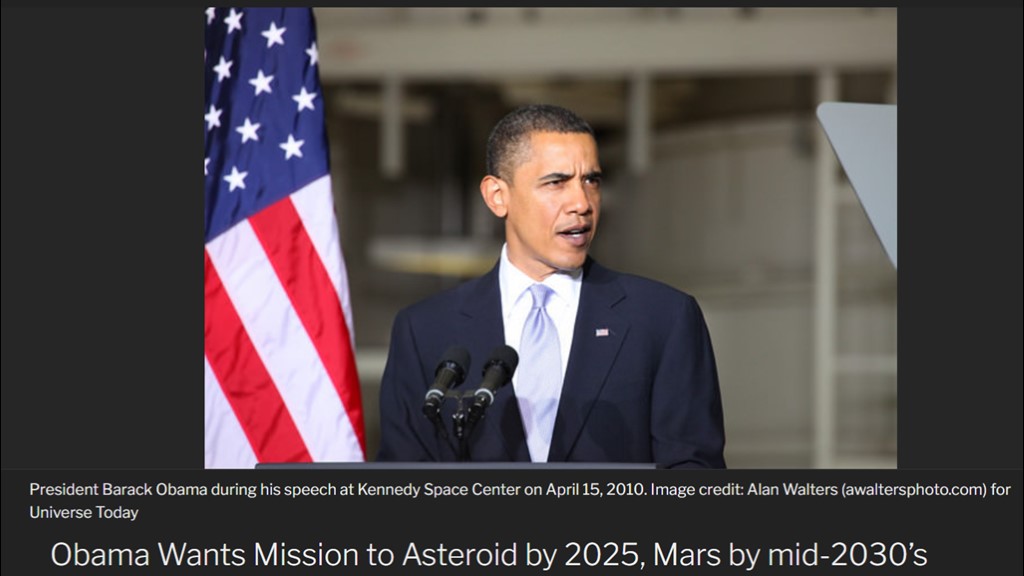
Obama had directed NASA to skip going to the moon in favor of visiting an asteroid and then going to Mars.
The asteroid visit quickly got shot down; getting humans to a near-earth asteroid to collect samples and returns is really, really hard - surely harder than a moon mission and probably harder than a Mars mission.
So NASA flexed and came up with a new mission...
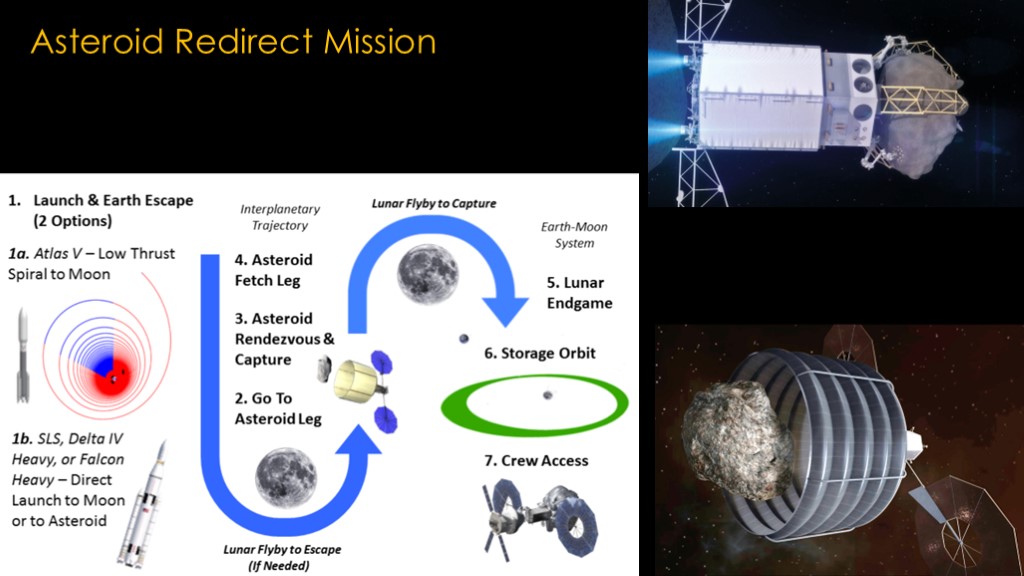
NASA would launch a small probe to rendezvous with a near-earth asteroid to either capture a small asteroid or pick up a boulder from the surface of a larger asteroid. It would then return that material into a storage orbit around the moon. It would be a very long mission; about 3 years to get to the asteroid and another 4 years to get the asteroid back into the storage orbit. The long timespans are because the probe would need to use very efficient but low thrust ion thrusters to be able to accomplish the mission.
That illustrates pretty well why a crewed mission wasn't possible...
Once the asteroid was in a distant retrograde lunar orbit, NASA would launch an Orion to dock with the probe, and astronauts would do EVAs to grab pieces of the asteroid and bring them inside the probe/capsule for study.
NASA called it the "Asteroid Redirect Mission" which appears to be an attempt to make people think this was a planetary protection mission rather than a science one.
If you are asking why NASA didn't bring the asteroid back to the ISS where they could perform the analysis and easily return samples back to earth, shame on you. The point is coming up with a use for SLS and Orion, not to do things efficiently.
NASA did quite a bit of work figuring out what it would take to modify Orion for the mission, but the main problem was that it didn't provide much use for SLS and Orion - only one or two launches.
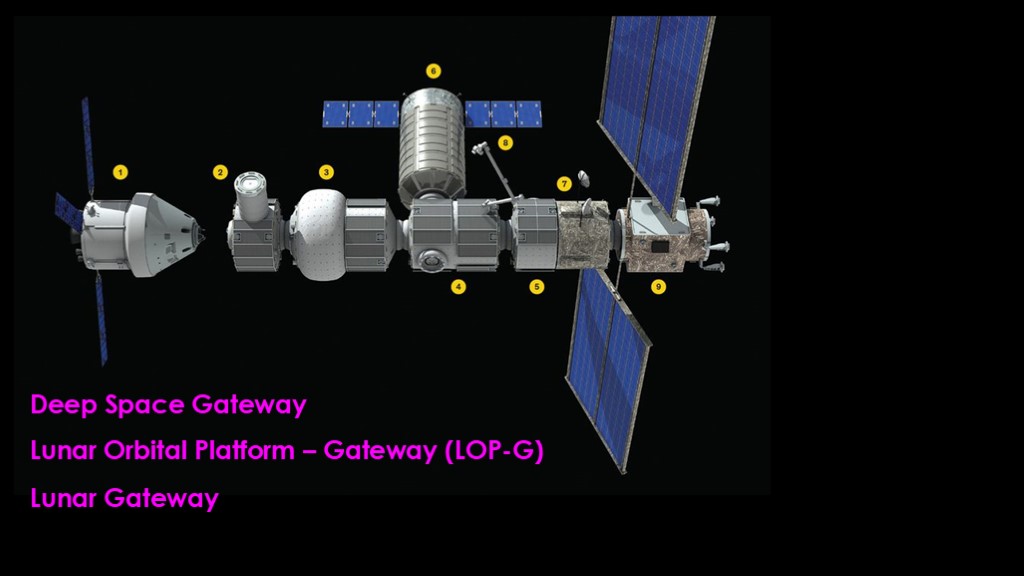
During this period NASA began working on designs for a full space station. Some of these were planned to be in the same distant retrograde orbit that the asteroid mission would have used, but they were also studying the near rectilinear halo orbit as that gave access both to deep space and the lunar surface.
During this time the station went from being named the deep space gateway to the lunar orbital platform - gateway, or "LOP-G", and finally to the Lunar Gateway.
Why does NASA want a new space station? There are two big factors
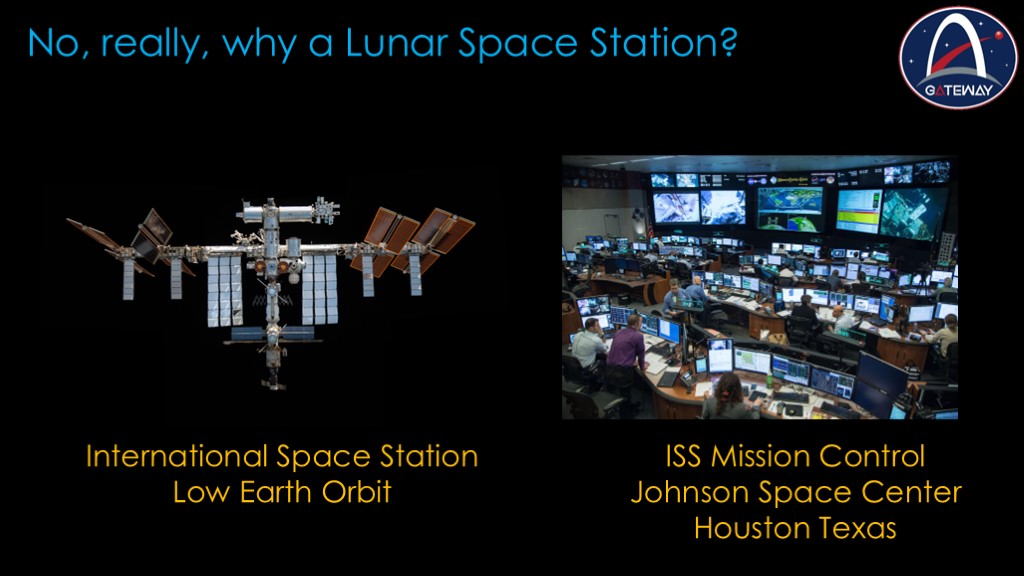
For years the main US mission control center has been at Johnson Space Center in Houston Texas. It has handled NASA flights since Gemini 4 in 1965, covering all the Apollo flights, all the shuttle flights, and since shuttle retired, it has become the ISS mission control center.
ISS is scheduled to go away in 2030. Mission control will still need to handle the Artemis missions, but those are planned to run once a year for a few weeks. If there are commercial space stations that NASA uses, those companies will have their own mission control centers.
Johnson stands to lose a lot of work and therefore a lot of jobs when this happens and that isn't something that the management at Johnson and the politicians in Texas want to happen.
The solution is gateway. It's a space station and while it doesn't have people in it all the time, it still needs to be managed all the time.

The second reason is related to SLS.
To get SLS launched quickly, NASA adapted an upper stage from the Delta IV rocket and named it the ICPS. It works fine but because it was designed for Delta IV, it's comically small for SLS and can only put Orion into lunar orbit.
NASA is working on a more appropriately sized upper stage - the exploration upper stage - so that it can carry both Orion and extra cargo to lunar orbit. That is the SLS Block 1B version.
Currently, the only cargo it might carry is gateway modules, so Gateway provides a justification for spending a lot of money - at least $5B - on SLS block 1B.
NASA was set. They would get SLS block 1B finished and use it to launch gateway and that makes gateway a part of the moon program.
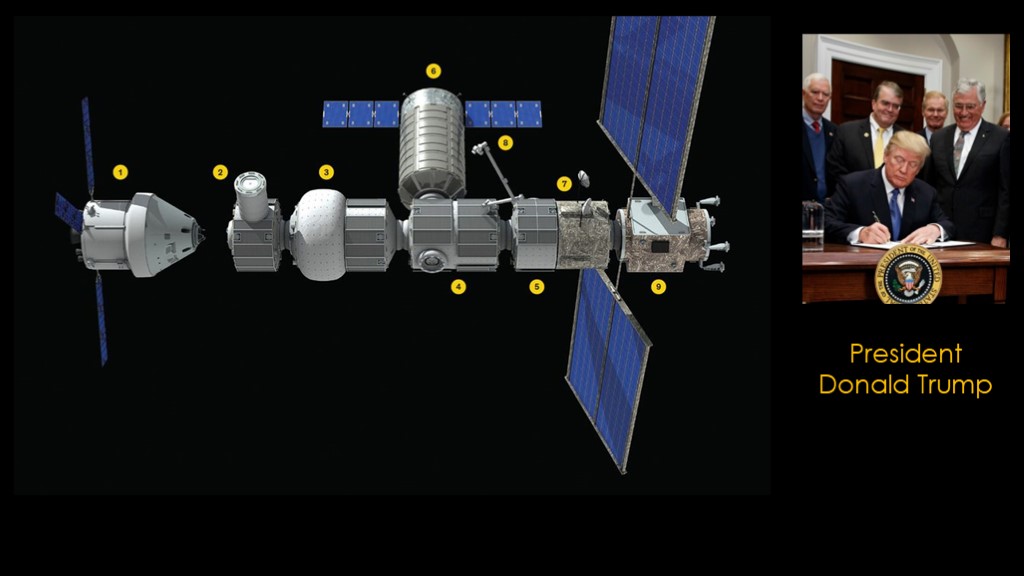
But then - as often happens - another president has different ideas...
In 2017, President Donald Trump issued a memorandum known as "space policy directive 1" and essentially flipped from the Obama policy of going to mars back to the George W. Bush policy of going back to the moon first. President Trump wanted to get back to the moon "real quick like" (not an actual quote).
That presented a real problem.
The development of the exploration upper stage and the second mobile launcher has been continually delayed and would not be ready quickly enough. NASA needed a plan to do a lunar mission without the lunar gateway.

The solution was to restructure the Artemis 3 flight so that it could complete the first mission back to the lunar surface without gateway, with a target of 2024, since moved out to 2026.
The obvious problem here is that if you can complete a lunar landing without gateway, NASA's assertion that gateway is critical to lunar surface missions is a little harder to support.
So while all this artemis fun was happening, the gateway folks realized they might have a way around the Artemis 3 issue. In their original plan they couldn't launch any modules until Artemis IV and you need two modules to make gateway minimally useful, so that's after Artemis V.
But if you put the first two modules together and launched them on a Falcon Heavy, they could launch them in 2027 and get there in 2028, approximately when Artemis IV would launch. Assuming Artemis IV is a block 1b SLS, that would give NASA 3 gateway modules for the second lunar landing flight.
And that's the story of gateway and why NASA is spending money on it.
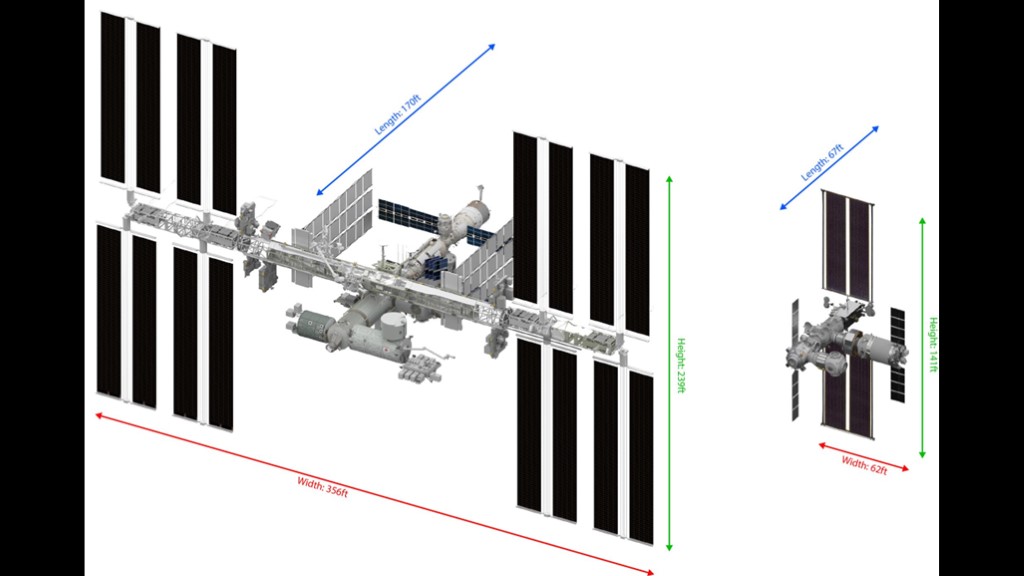
At this point it's helpful to learn a little bit more about gateway. It's a bit like a mini version of the international space station in terms of overall size.
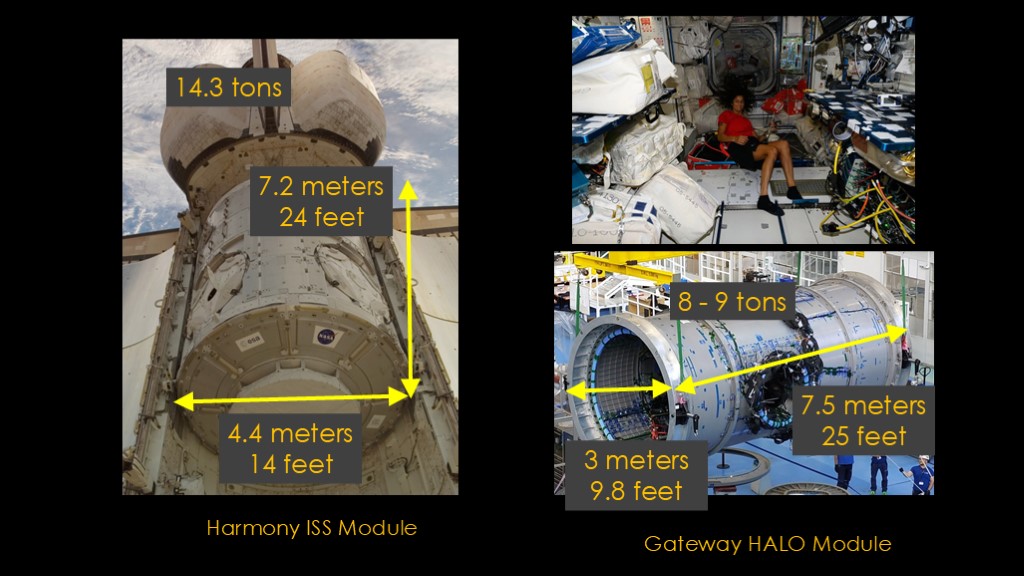
It's also smaller when it comes to the modules themselves.
This is the ISS module Harmony nestled inside the payload bay of Discovery. At 4.4 meters or 14 feet in diameter the module pretty much fills up the entire payload bay of shuttle, and it's 7.2 meters or 24 feet long. It has a mass of 14.3 tons.
The gateway Halo habitation and logistics module is only 3 meters in diameter and 7.5 meters long and is expected to mass 8 to 9 tons.
This small diameter has proven to be challenging.
This picture shows astronaut Suni Williams inside the harmony module on ISS, and notice how much space is taken up by machinery, equipment and storage.
Now take away about 1.4 meters, or 4 feet of the diameter. Even with significant work to save space, gateway will be pretty cramped.
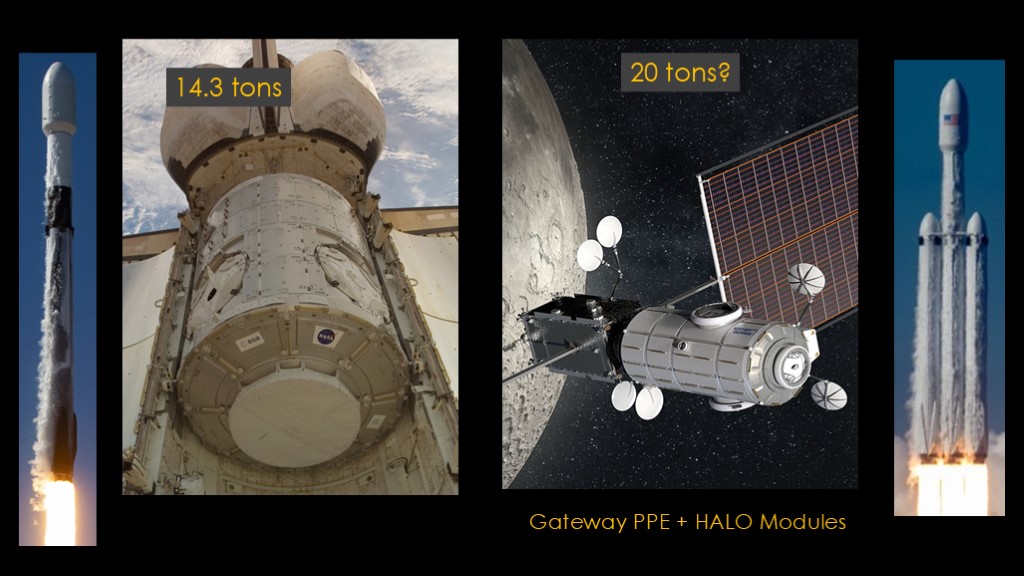
The other issue is mass...
Falcon 9 could easily launch a module like harmony to a low earth orbit and land the first stage downrange on a drone ship, but gateway is in a much tougher-to-reach destination.
Launching the gateway power and propulsion module and the halo habitation module together can be done in a single Falcon Heavy launch as long as the modules hit their mass targets, which so far has been problematic for NASA. That doesn't actually get them to lunar orbit but to an orbit where gateway can get the rest of the way there by itself, as long as you're okay with it taking a year.
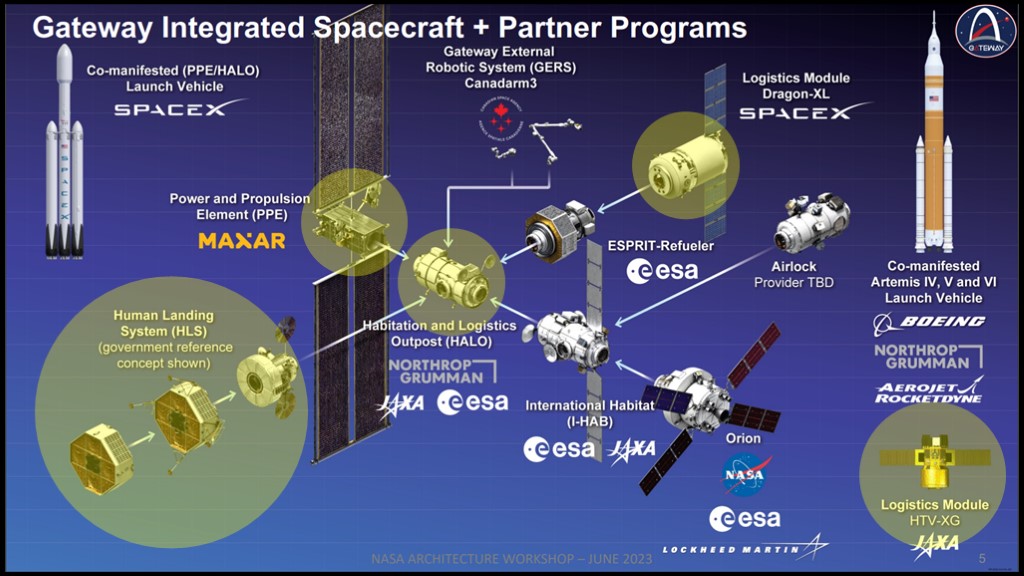
That single launch - currently planned for 2027 - gives us the two core modules for the gateway station.
If you look at the modules, you will find a lot of international partners, and the plan is to carry those other modules to gateway starting with the Artemis IV mission.
The exceptions are the SpaceX or Blue Origin lunar landing systems, which get to gateway by themselves, and the Dragon XL and HTV-XG logistics modules.
The challenge and cost to get to a lunar orbit - and the current limitation that the only way for astronauts to get there is on an Orion on top of an SLS rocket - means that gateway will not be a continuously inhabited station like ISS. It will be inhabited once a year when lunar missions stop by, and the claim is that there might be crew there for up to 3 months.

How much will gateway cost?
I'm going to give my usual less-than-useful answer - we don't know.
And that's as unsatisfying as usual, so I'll tell you what I do know.
A general account office report on gateway notes that NASA committed to launching the gateway initial capacity - that's the PPE and HALO modules - by December 2027 at a cost of $5.3 billion.
We also find that between fiscal years 2018 and 2029, NASA anticipates spending over $7 billion to build and operate the gateway.
You can put whatever level of credence you think is appropriate on those cost estimates; the first one is only about 9 months old and it seems unlikely that it will survive until the launch in 2027.
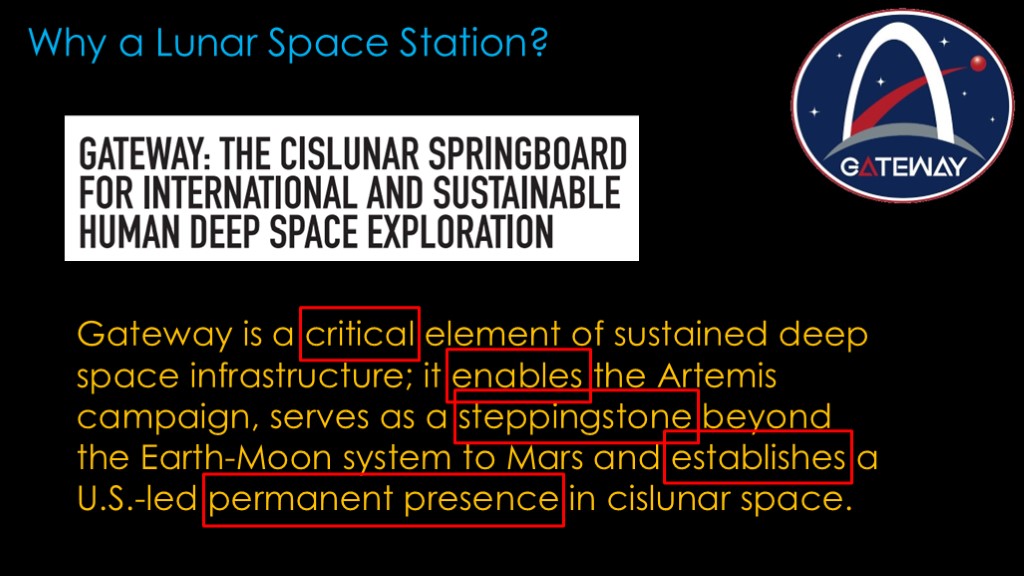
I've already covered why I think NASA wants to build gateway, but to be fair we should look at what NASA says.
In 2022 NASA wrote a white paper explaining gateway, and it starts this way.
Okay. That's not a terrible justification, but when I read this, a few of the words jump out at me.
Critical - why is it critical?
Enables - how does it enable?
Steppingstone - how does it make getting to mars easier?
Permanent presence - I do not think those words mean what you think they mean.
You should really go and read the white paper yourself - it's linked in the description - but I do have a few thoughts to share:
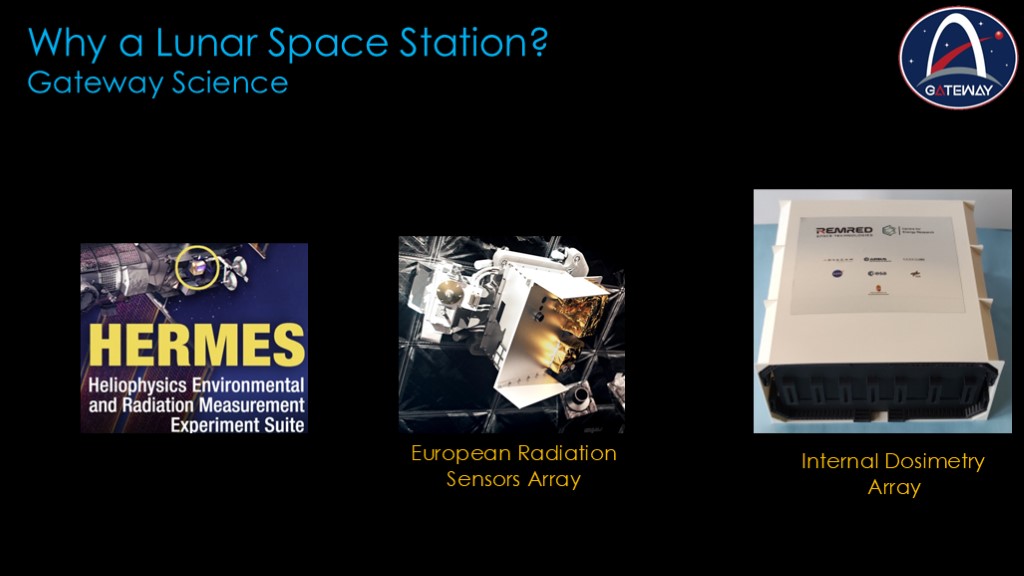
NASA talks about science and lists a few of the experiments that will fly on it.
The advantages of hosting your experiment on gateway is that you probably don't have to pay to get it into space and you will get services from the station that you would need to build into your spacecraft otherwise. And it's likely a lot cheaper and easier to get into the gateway program than it is to get NASA to fund you as an independent science mission. On the other hand, you can only fly once a year at best and your experiment has to be remotely operable.
I think there's a good argument to doing experiments on Gateway if you have strong reasons to build it, but I don't think there's a scientific justification to spend the money just to do science there.

NASA plans to use gateway as a waystation between the earth and the lunar surface. How will that work?
Artemis 3 is designed to land on the moon without gateway. Orion will launch with 4 astronauts, but only two of them will move to the starship lunar lander to spend six and a half days on the moon, despite starship having a huge amount of crew space compared to Orion.
The other two astronauts are stuck in Orion for a week. Or, if gateway happens to be done, they will spend that time camped out in Gateway.
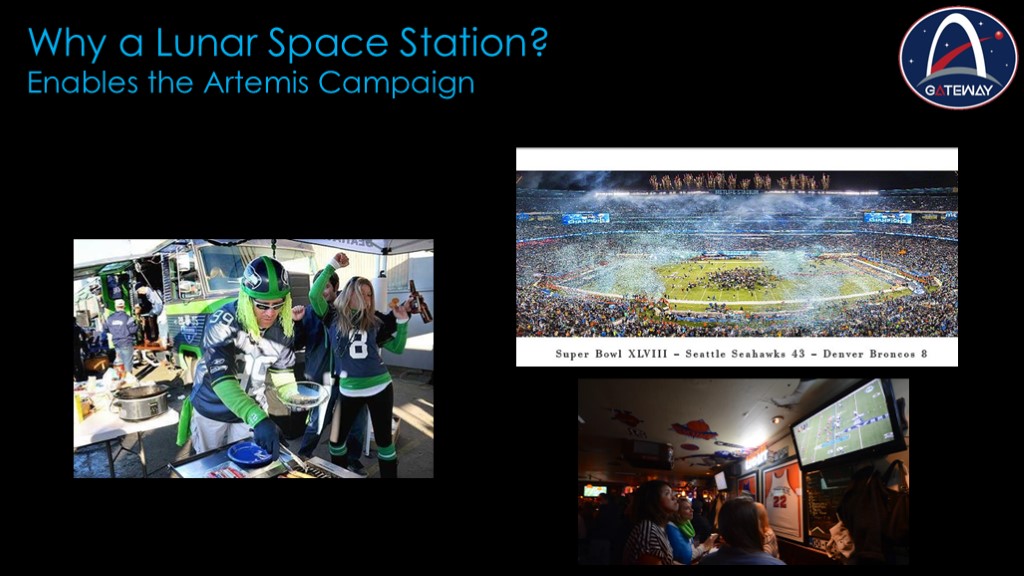
This is the worst space consolation prize.
You've worked for years to do something you dreamed about, you get to go to the initial party, but for the main event you are stuck watching it on TV like everybody else.
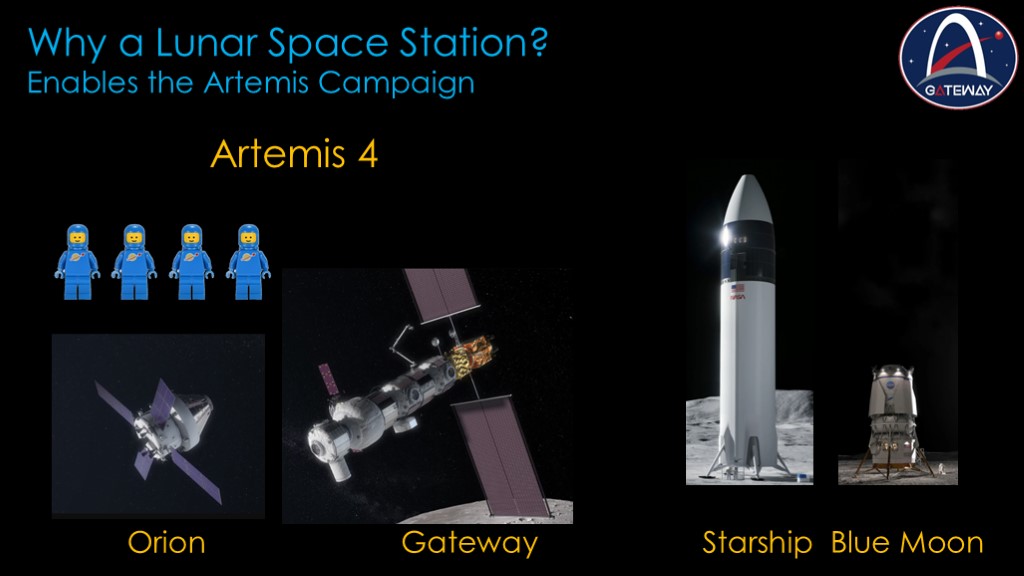
It's not clear what the plan is for Artemis 4 - the second starship lander is supposedly an enhanced version that could probably carry all 4 astronauts to the surface, so there may be no need for a place to chill while the surface astronauts do their stuff.
Blue Origin's blue moon lander is specified to carry 4 astronauts starting with artemis V.
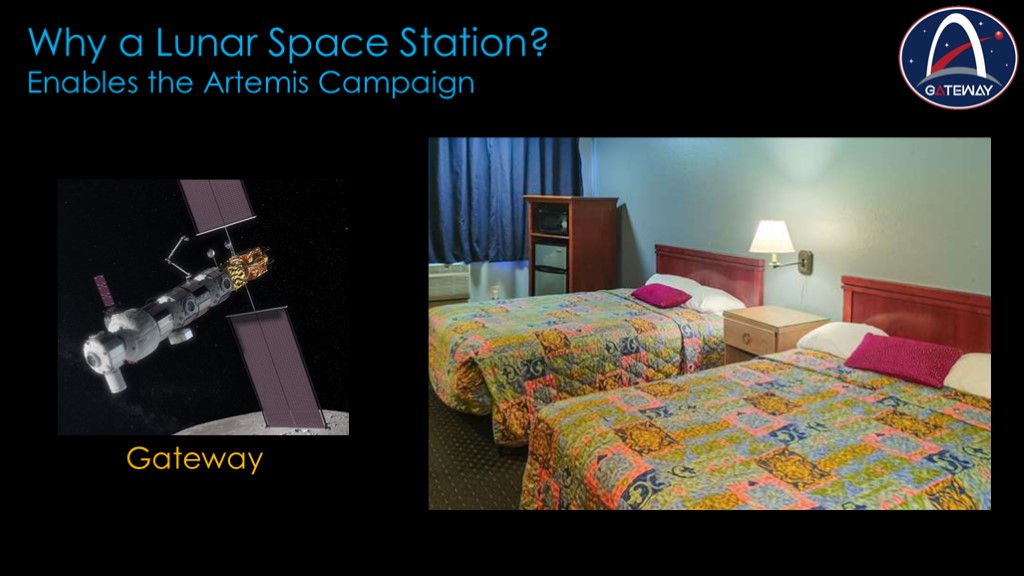
Gateway ends up being that cheap airport hotel you stay in because you can't get a flight that works for your schedule.
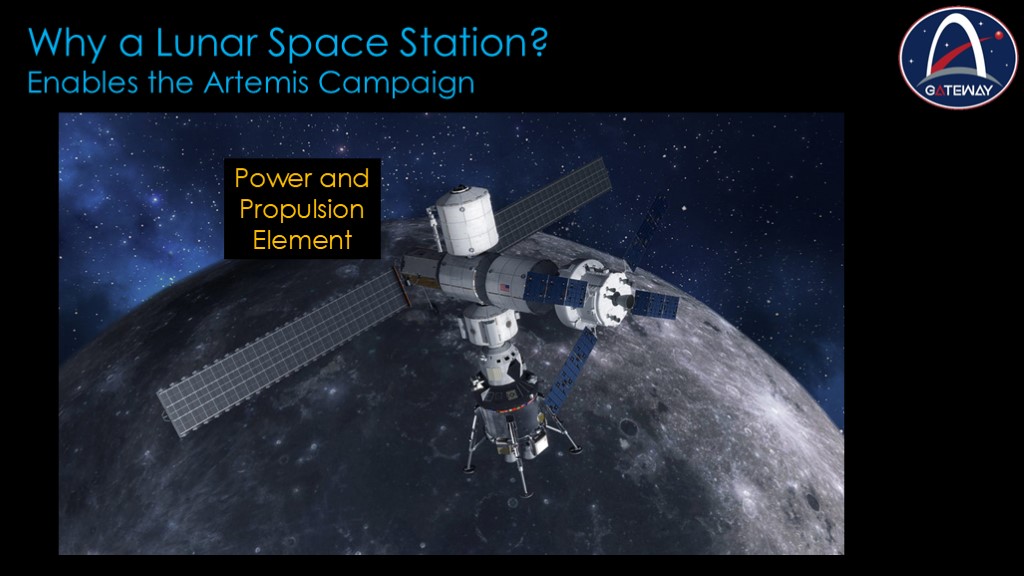
There's another problem that recently came to light.
When NASA designed the power and propulsion module that keeps the station properly oriented, they were thinking of small lunar landers like this Lockheed Martin proposal.
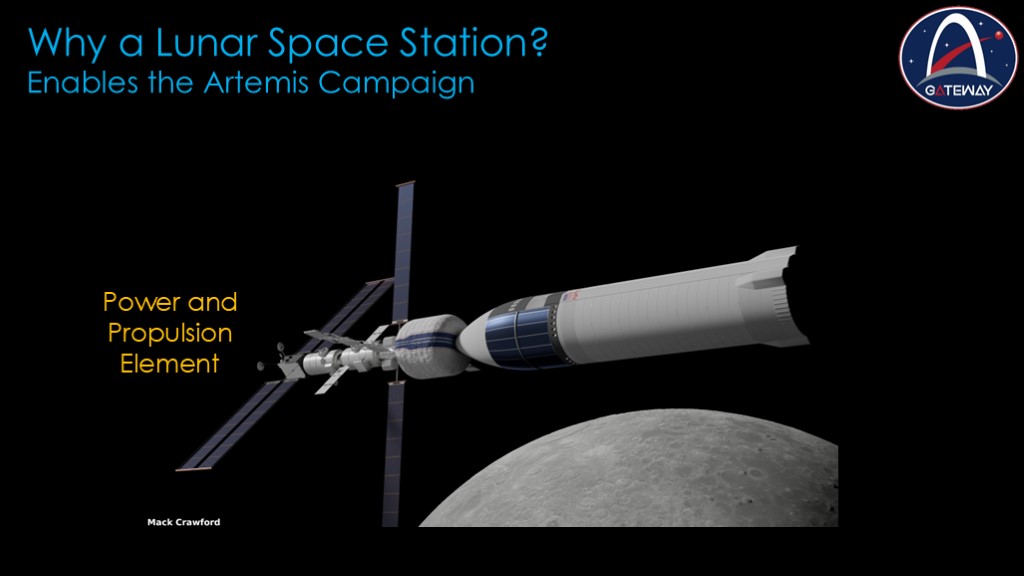
What NASA bought was this, an absolute giant of a lunar lander, one that has a mass approximately 18 times the mass used when designing the PPE module.
In simple terms, it is likely that the PPE cannot control the station when starship is docked.
This problem occurs to a lesser degree with smaller landers like Blue Moon and even with the cargo vehicles that dock with the station. It's not clear yet what the solution might be - it might involve revised software for PPE or it might involve coordinating the PPE thrusters with those of the visiting ship. Or worse, a redesigned PPE.
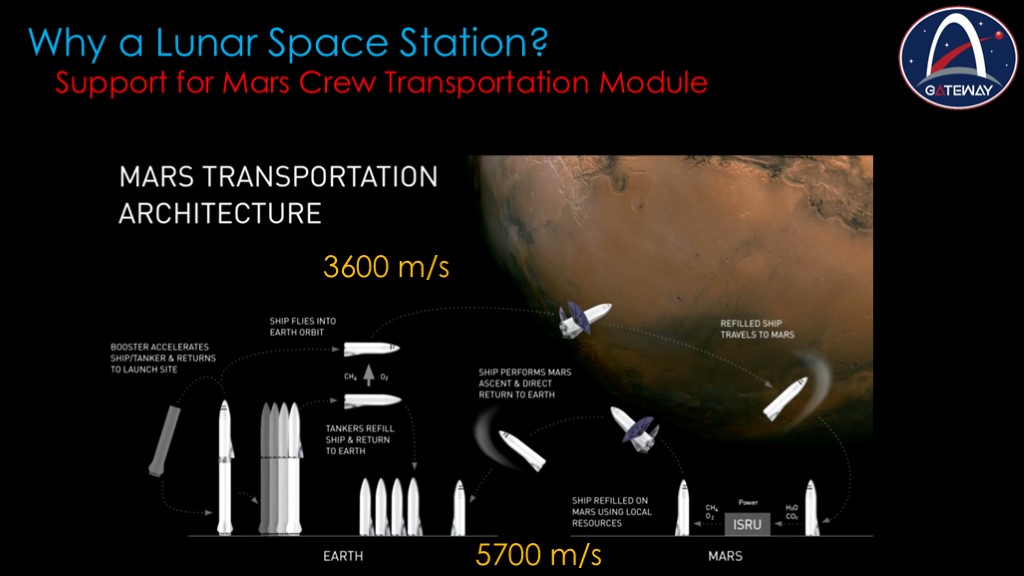
Another use that NASA mentions for Gateway is as a stop on the way to Mars.
To understand this, we'll need to contrast the SpaceX approach with the one that involves gateway.
In the SpaceX one, a Mars starship refuels in earth orbit - likely from a starship propellant depot - and then lands on Mars. It refuels there - either by making its own propellant or possibly from starship tankers - and then flies back to earth, reenters, and lands.
In this approach, you build your spacecraft on the ground, launch into orbit, and if everything is okay, head to Mars. If not, it's easy to get back to earth and fix things for another try.
Somewhat surprisingly, it's not that hard to get to Mars - it takes about 3600 meters per second of delta v from low earth orbit if you aerobrake on your way to landing on Mars, the same way capsules use the earth's atmosphere to slow down on reentry. It's actually a lot easier than getting to the surface of the moon.
Getting from Mars back to Earth is a lot harder than getting there, requiring 5700 meters per second of delta v.
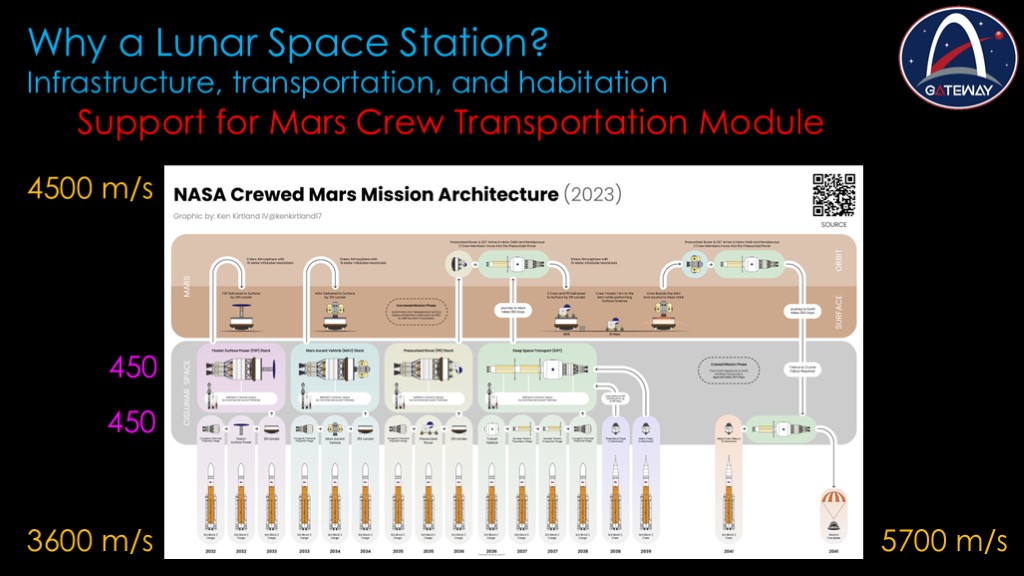
This wonderful graphic from Ken Kirtland IV shows the NASA Mars Mission Architecture. I don't want to get into the details, but in this design the Mars spacecraft is assembled at gateway.
In our mars direct approach, it took 3600 meters per second of delta v to get to mars and 5700 meters per second to get back.
In this approach, we need to get all of our spacecraft parts into the near rectilinear halo orbit that gateway uses. It's not particularly expensive, but it still takes 450 meters per second to get in and 450 meters per second to get out, bumping up our total to get to from low earth orbit to Mars from 3600 to 4500 meters per second, a 25% increase.
Using gateway means you are assembling your spacecraft in a remote location that increases your fuel costs.
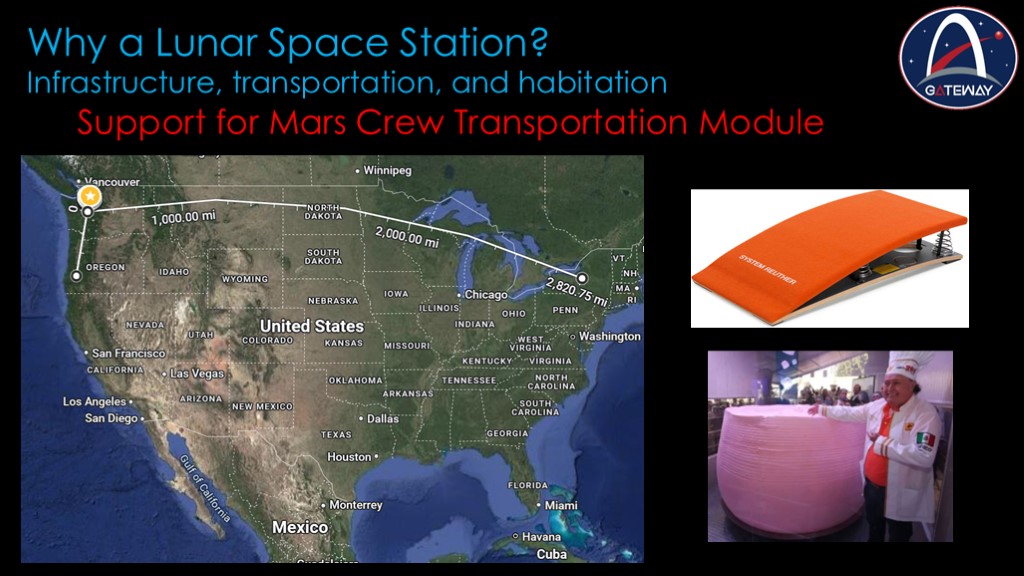
This is like me wanting to fly from seattle to Syracuse New York, but deciding to do it by flying to southern Oregon, staying there for a week, then flying on a different plane back to seattle and then turning to fly directly to Syracuse without landing.
All this approach does is make the architecture more difficult and riskier.
NASA likes to call gateway a springboard to Mars, but from an energy standpoint it's space's largest marshmallow soaking up energy that we could use to carry more payload.
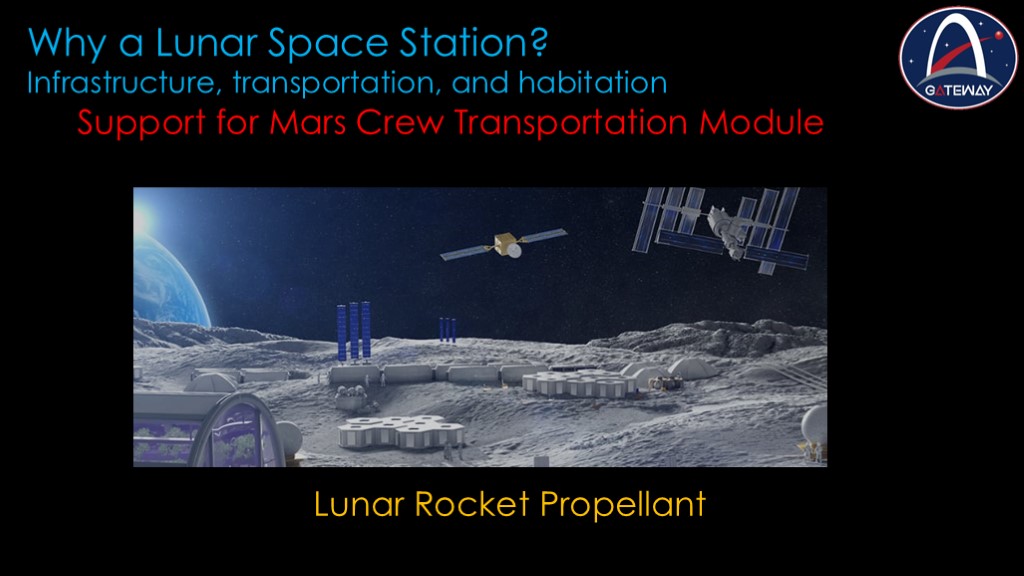
There is a caveat.
If you can build enough lunar industrial capacity to create rocket propellant and launch it into orbit - and be able to do it cheaper than propellant lifted from the earth - then stopping off at the moon on the way to Mars may make sense.
We're a long way from that capability at this time.
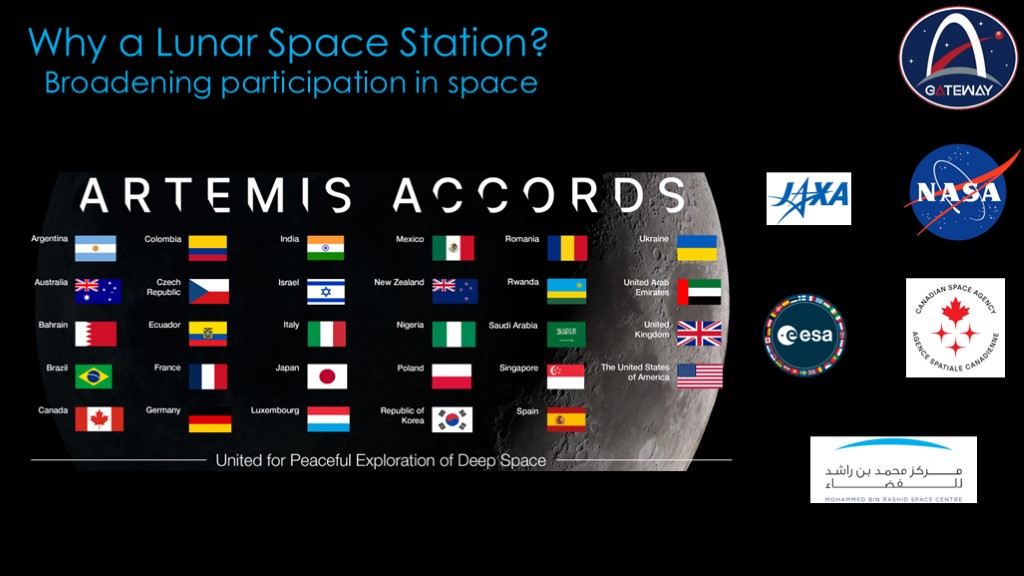
NASA also argues that gateway builds on the international cooperation on ISS and aligns with the goals of the Artemis Accords.
Gateway involves the usual suspects - JAXA, NASA, ESA, CSA, and adds in one new entrant, the united arab emirates.
All of those groups will be expecting trips to the lunar surface for their astronauts as part of participating in Gateway. The rest of the Artemis Accords countries can expect no trips to the lunar surface as part of Artemis because Orion is too expensive and flies so rarely, and it's not like there is any other current solution to take them to Gateway to spend time there.
NASA persists in implying that the Artemis moon program and the Artemis accords are tightly linked. SLS and Orion are mostly NASA programs with an assist from the ESA for the Orion service module.
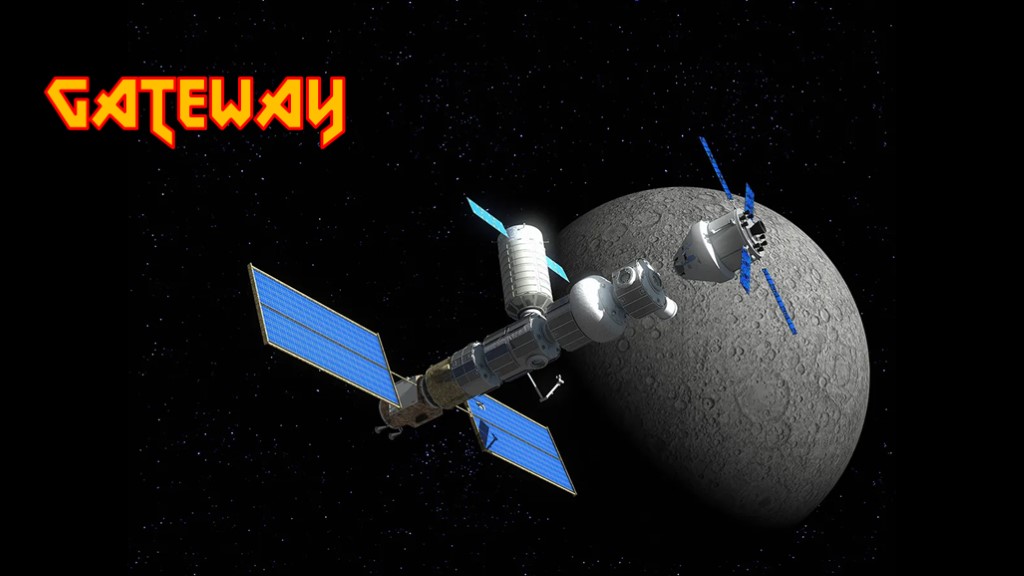
And that's the story.
If NASA wants to build an international partnership around the moon, it should be spending its effort on the lunar surface, because that's where everybody wants to go, and there's a lot more variety of things to be done on the moon than in orbit around it.
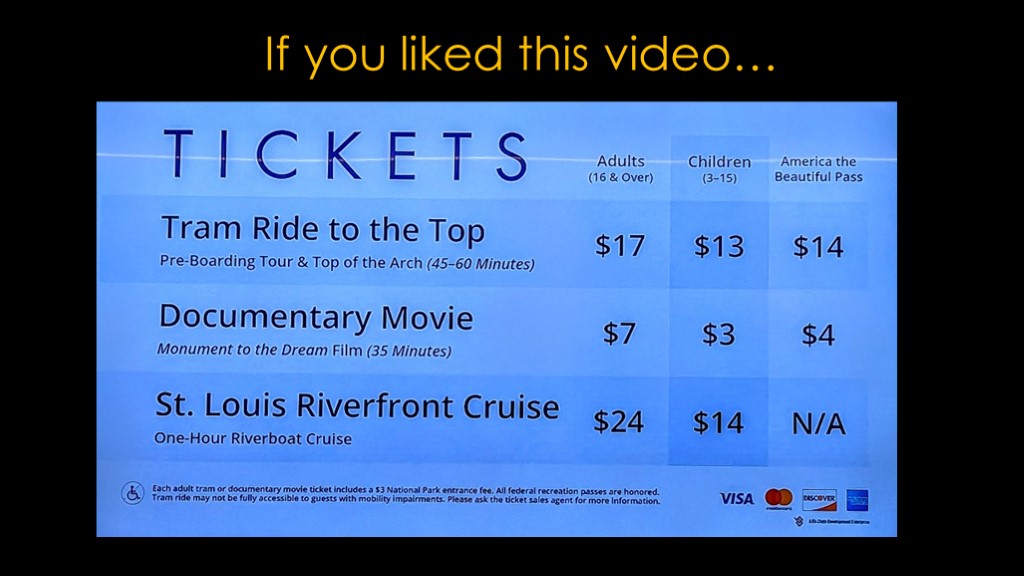
If you liked this video, I'd love some tickets to see the gateway...

But actually, what I'd really like you to do is go to the Mia and the Martians project on indiegogo and pledge your support.
What this world needs is more cool space books for kids.
Link is in the description, along with a link to the Off Nominal podcast discussion of the book.